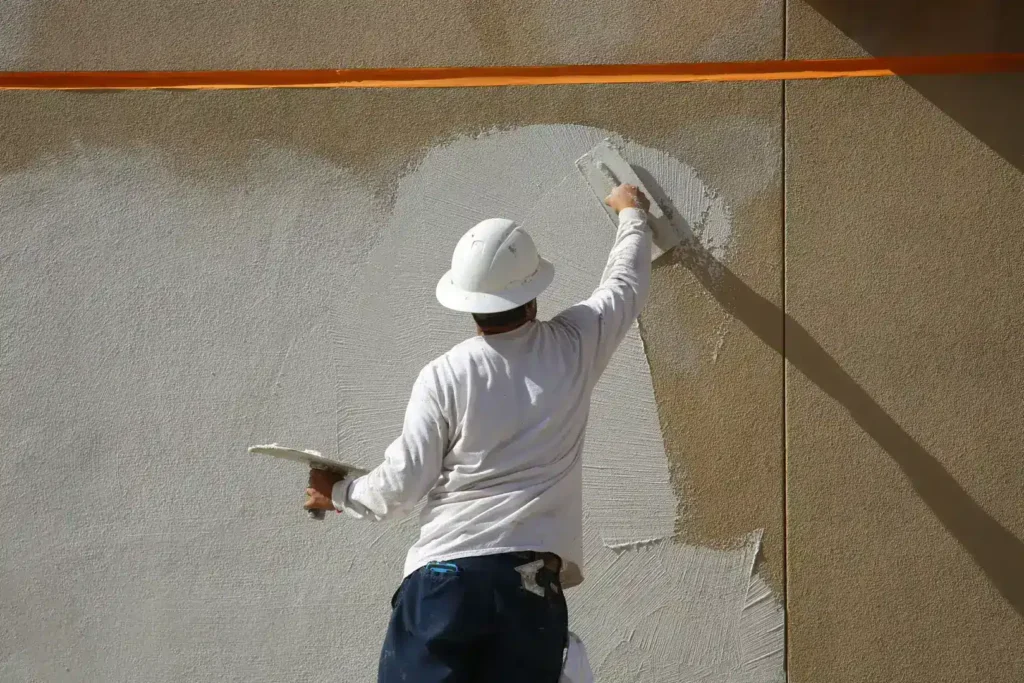A common exterior treatment, stucco is renowned for its strength, resilience to weather, and visual appeal. A tried-and-true technique, the classic three-coat stucco system creates sturdy, attractive walls with long-lasting protection. Understanding the three-coat stucco application method guarantees excellent adhesion, resistance to cracking, and a visually appealing finish, whether it is applied to masonry or frame structure. To get the best outcomes during a building’s lifetime, homeowners and contractors must also incorporate relevant maintenance procedures like brick restoration when needed.
Surface preparation is the first step in a proper stucco installation, which is followed by the meticulous application of the scratch, brown, and finish coats. Every coat has a distinct structural and functional role. Longer-lasting exteriors and high-quality workmanship are made possible by understanding these stages.
- Setting Up The Surface For The Installation Of Stucco
The surface needs to be dry, clean, and free of loose material, oils, and grime before stucco is applied. Because a firm foundation keeps stucco from cracking or detaching, it is essential to do brick repair when laying over brick to fill in fractures or replace damaged areas. A sturdy foundation for stucco adhesion is created for frame building by covering a weather-resistant barrier with metal lath or synthetic mesh.
Surfaces that have been properly prepared guarantee an excellent first coat bond. Premature drying can be minimized and the initial coat’s cure improved by lightly moistening the substrate before application.
- The Scratch Coat: The Basis of Power
The initial layer, known as the scratch coat, is usually applied over the lath or masonry and is about 3/8 inch thick. It is usually a mixture of Portland cement, sand, lime, and water. The scratch coat is applied uniformly, then scored to form horizontal grooves with a rake or scratching instrument. The ensuing brown coat has better mechanical bonding thanks to these grooves.
The scratch coat needs to cure completely, which typically takes 24 to 48 hours, depending on humidity and temperature. In order to prevent poor adhesion and subsequent cracking, proper curing is necessary. The strength of the stucco system is largely dependent on this layer.
- Using The Brown Coat: Base Enrichment And Leveling
The brown coat is applied at a comparable thickness (about 3/8 inch) after the scratch coat has dried. The brown coat creates a level, uniform surface for the final finish and smoothes out any flaws in the scratch coat. Additionally, the fibers or additives in this coat increase the stucco’s elasticity and help shield it against breaking brought on by shrinkage or structural movement.
The brown coat is smoothed using a darby or long trowel, which usually takes a further 48 hours to cure. The overall strength and endurance of the stucco work are greatly enhanced by the proper application of the brown coat.
- The Final Coat: Protection And Texture
To get the required texture and color, a thin, decorative layer is applied as the final coat. It is usually 1/8 inch thick and comes in a variety of styles, including patterned, rough, and smooth finishes. In addition to improving aesthetic appeal, the finish coat serves as a weatherproof barrier.
Acrylic polymers are frequently used in contemporary finish coatings to increase their flexibility and water resistance. To guarantee adhesion and long-term performance, the finish coat must be compatible with the underlying coats.
- Maintenance: Handling Brick Repair And Safeguarding Your Stucco
Although properly applied three-coat stucco requires little upkeep, it should be inspected for cracks and water damage on a regular basis. If any mortar joints fail or bricks deteriorate beneath the stucco, it is imperative to promptly repair the bricks. Failure to do so may jeopardize the stability of the stucco.
Water infiltration behind the stucco is prevented by checking weep screeds and flashing, controlling surrounding vegetation, and maintaining drainage. Promptly addressing damage and controlling moisture prolongs the life of the supporting brick structure and stucco while avoiding expensive repairs.
Understanding Three-Coat Stucco For Durability And Beauty
For external walls, the classic three-coat stucco installation method—scratch, brown, and finish coats—offers unparalleled strength, weather resilience, and visual versatility. As stucco is installed correctly and bricks are repaired as needed, the result is a long-lasting, visually appealing exterior.
Understanding and carefully using this approach produces stunning, long-lasting effects that safeguard and improve your property, whether you’re building a new structure or remodeling an old one.
You may also like
-
Clear Views Ahead: Why Professional Window Replacement Is Worth The Investment
-
Well Pump Automation: Enhancing Convenience and Efficiency
-
Building a Cost-Effective Glass Office: A Practical Guide
-
Enhance Your Home’s Safety With New Storm Rated Garage Doors
-
Transform Your Outdoors with Stunning Landscape Lighting

